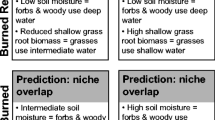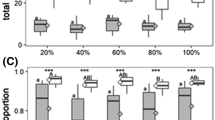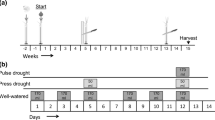Abstract
In the northern elk wintering range of Yellowstone National Park, USA, wolf (Canis lupus) removal allowed elk (Cervus elaphus) to overbrowse riparian woody plants, leading to the exclusion of beaver (Castor canadensis) and a subsequent water table decline in many small stream valleys. Reduced elk browsing following wolf reintroduction may or may not facilitate willow (Salix sp.) recovery in these areas. To determine if the effect of elk browsing on willow interacts with that of beaver abandonment, we manipulated elk browsing and the water table in a factorial experiment. Under the condition of an ambient (low) water table, elk browsing increased shoot water potential (Ψ s), photosynthesis per unit leaf area (A), stomatal conductance per unit leaf area (g s), and aboveground current annual growth (CAG) by 50%. Elk browsing occurred entirely during dormancy and did not affect total plant leaf area (L). Improved water balance, photosynthetic rate, and annual aboveground productivity in browsed willows appeared to be due to morphological changes, such as increased shoot diameter and decreased branching, which typically increase plant hydraulic conductivity. An elevated water table increased Ψ s, A, g s, CAG, and L, and eliminated or lessened the positive effect of browsing on CAG for most species. Because low water tables create conditions whereby high willow productivity depends on the morphological effects of annual elk browsing, removing elk browsing in areas of water table decline is unlikely to result in vigorous willow stands. As large willow standing crops are required by beaver, a positive feedback between water-stressed willow and beaver absence may preclude the reestablishment of historical conditions. In areas with low water table, willow restoration may depend on actions to promote the re-establishment of beaver in addition to reducing elk browsing.








Similar content being viewed by others
References
Alder NN, Pockman WT, Sperry JS, Nuismer S (1997) Use of centrifugal force in the study of xylem cavitation. J Exp Bot 48:665–674
Alstad KP, Welker JM, Williams SA, Trlica MJ (1999) Carbon and water relations of Salix monticola in response to winter browsing and changes in surface water hydrology: an isotopic study using delta C-13 and delta O-18. Oecologia 120:375–385
Baker BW, Ducharme HC, Mitchell DCS, Stanley TR, Peinetti HR (2005) Interaction of beaver and elk herbivory reduces standing crop of willow. Ecol Appl 15:110–118
Bilyeu DM, Cooper DJ, Hobbs NT (2007a) Assessing impacts of large herbivores on shrubs: tests of scaling factors for utilization rates from shoot-level measurements. J Appl Ecol 44:168–175
Bilyeu DM, Cooper DJ, Hobbs NT (2007b) Water tables constrain height recovery of willow on Yellowstone’s Northern Range. Ecol Appl (in press)
Binkley D, Moore MM, Romme WH, Brown PM (2006) Was Aldo Leopold right about the Kaibab deer herd? Ecosystems 9:227–241
Brodribb TJ, Feild TS (2000) Stem hydraulic supply is linked to leaf photosynthetic capacity: evidence from New Caledonian and Tasmanian rainforests. Plant Cell Environ 23:1381–1388
Brunsfeld SJ, Johnson FD (1985) Field guide to the willows of east central Idaho. University of Idaho, Moscow
Committee on Ungulate Management in Yellowstone National Park NRC (2002) Ecological dynamics on Yellowstone’s Northern Range. The National Academies Press, Washington D.C.
Consolo Murphy S, Hanson DD (1990) Current distribution of beaver in Yellowstone National Park. In: Varley JD, Brewster WG (eds) Wolves for Yellowstone? A report to the United States Congress, vol 2: research and analysis. National Park Service, Yellowstone National Park, pp 221–235
Cote SD, Rooney TP, Tremblay JP, Dussault C, Waller DM (2004) Ecological impacts of deer overabundance. Annu Rev Ecol Evol Syst 35:113–147
Despain DG (1987) The two climates of Yellowstone National Park. Proc Mont Acad Sci 47:11–20
Engstrom DR, Whitlock C, Fritz SC, Wright HE (1991) Recent environmental change inferred from the sediments of small lakes in Yellowstone’s Northern Range. J Paleolimnol 5:139–174
Ewers FW, Zimmermann MH (1984) The hydraulic architecture of Eastern Hemlock (Tsuga canadensis). Can J Bot 62:940–946
Fortin D, Beyer HL, Boyce MS, Smith DW, Duchesne T, Mao JS (2005) Wolves influence elk movements: behavior shapes a trophic cascade in Yellowstone National Park. Ecology 86:1320–1330
Hebblewhite M et al (2005) Human activity mediates a trophic cascade caused by wolves. Ecology 86:2135–2144
Houston DB (1982) The northern Yellowstone elk: ecology and management. MacMillan, New York
Hubbard RM, Bond BJ, Ryan MG (1999) Evidence that hydraulic conductance limits photosynthesis in old Pinus ponderosa trees. Tree Physiol 19:165–172
Hubbard RM, Ryan MG, Stiller V, Sperry JS (2001) Stomatal conductance and photosynthesis vary linearly with plant hydraulic conductance in ponderosa pine. Plant Cell Environ 24:113–121
Jonas RJ (1955) A population and ecological study of beaver (Castor canadensis) of Yellowstone National Park. University of Idaho, Moscow
Joyce BJ, Steiner KC (1995) Systematic variation in xylem hydraulic capacity within the crown of white ash (Fraxinus Americana). Tree Physiol 15:649–656
Keigley RB, Frisina MR (1998) Browse evaluation by analysis of growth form: Volume I methods for evaluating condition and trend. Montana Fish Wildlife and Parks, Bozeman
Kindschy RR (1985) Response of red willow to beaver use in southeastern Oregon. J Wildl Manage 49:26–28
Kopp RF, Abrahamson LP, White EH, Burns KF, Nowak CA (1997) Cutting cycle and spacing effects on biomass production by a willow clone in New York. Biomass Bioenerg 12:313–319
Lockhart JA (1965) Cell extension. In: Bonner J, Varner JE (eds) Plant biochemistry. Academic, New York, pp 826–849
Meinzer FC, Grantz DA (1990) Stomatal and hydraulic conductance in growing sugarcane: stomatal adjustment to water transport capacity. Plant Cell Environ 13:383–388
Peinetti HR, Menezes RSC, Coughenour MB (2001) Changes induced by elk browsing in the aboveground biomass production and distribution of willow (Salix monticola Bebb): their relationships with plant water, carbon, and nitrogen dynamics. Oecologia 127:334–342
Raven JA (1992) The physiology of Salix. Proc R Soc Edinb B 98:49–62
Ripple WJ, Beschta RL (2004) Wolves and the ecology of fear: can predation risk structure ecosystems? Bioscience 54:755–766
Rooke T, Bergstrom R, Skarpe C, Danell K (2004) Morphological responses of woody species to simulated twig browsing in Botswana. J Trop Ecol 20:281–289
Ryan MG, Yoder BJ (1997) Hydraulic limits to tree height and tree growth. Bioscience 47:235–242
Singer FJ, Mark LC, Cates RC (1994) Ungulate herbivory of willows on Yellowstone northern winter range. J Range Manage 47:435–443
Smith DW, Consolo Murphy S, Phillips MK, Crabtree R (1996) Beaver survey. Yellowstone National Park, Mammoth
Smith DW, Peterson RO, Houston DB (2003) Yellowstone after wolves. Bioscience 53:330–340
Soule ME, Estes JA, Miller B, Honnold DL (2005) Strongly interacting species: conservation policy, management, and ethics. Bioscience 55:168–176
Sperry JS, Donnelly JR, Tyree MT (1988) A method for measuring hydraulic conductivity and embolism in xylem. Plant Cell Environ 11:35–40
Stolter C, Ball JP, Julkunen-Tiitto R, Lieberei R, Ganzhorn JU (2005) Winter browsing of moose on two different willow species: food selection in relation to plant chemistry and plant response. Can J Zool 83:807–819
Suding KN, Gross KL, Houseman GR (2004) Alternative states and positive feedbacks in restoration ecology. Trends Ecol Evol 19:46–53
Tardieu F, Granier C, Muller B (1999) Modelling leaf expansion in a fluctuating environment: are changes in specific leaf area a consequence of changes in expansion rate? New Phytol 143:33–44
Tyree MT, Ewers FW (1991) The hydraulic architecture of trees and other woody-plants. New Phytol 119:345–360
Tyree MT, Kolb KJ, Rood SB, Patino S (1994) Vulnerability to drought-induced cavitation of riparian cottonwoods in Alberta – a possible factor in the decline of the ecosystem. Tree Physiol 14:455–466
vandeKoppel J, Rietkerk M, Weissing FJ (1997) Catastrophic vegetation shifts and soil degradation in terrestrial grazing systems. Trends Ecol Evol 12:352–356
Warren RE (1926) A study of beaver in the Yancey region of Yellowstone National Park. Roosevelt Wild Life Ann 1:13–191
Westbrook CJ, Cooper DJ, Baker BW (2006) Beaver dams and overbank floods influence groundwater-surface water interactions of a Rocky Mountain riparian area. Water Resour Res 42:W0640 (doi: 10.1029/2005WR004560)
Wikberg J, Ogren G (2004) Interrelationships between water use and growth traits in biomass-producing willows. Trees Struct Funct 18:70–76
Wolf EC, Cooper DJ, Hobbs NT (2007) Beaver, stream flow, and elk influence willow establishment and floodplain stability on Yellowstone’s Northern Range. Ecol Appl (in press)
Woodruff DR, Bond BJ, Meinzer FC (2004) Does turgor limit growth in tall trees? Plant Cell Environ 27:229–236
Zimmermann MH (1978) Hydraulic architecture of some diffuse-porous trees. Can J Bot 56:2286–2295
Zimmermann MH (1983) Xylem structure and the ascent of sap. Springer, New York
Acknowledgments
This work was funded by grants from the Biological Resources Divisions of the U.S. Geological Survey, Yellowstone National Park, and the National Science Foundation (Graduate Research Fellowship Program and Ecosystems Studies Program Award granted to Colorado State University). We thank John S. Sperry and Uwe G. Hacke for generous assistance in developing the vulnerability curves, Michael G. Ryan for help in interpreting the physiological data, and Alan K. Knapp for use of a Li-Cor 6400 portable photosynthesis system. We thank the staff at the Yellowstone Center for Resources for logistical and technical support, particularly Roy A. Renkin, Mary Hektner, Glenn E. Plumb, and Christie Hendrix. We thank the Montana Conservation Corps, the Youth Conservation Corps, Paul Miller, and Evan Wolf for help in constructing exclosures and dams, many field assistants for help in taking willow measurements, and Christopher Williams for helpful suggestions on an early manuscript. This work complies with the current laws of the United States of America.
Author information
Authors and Affiliations
Corresponding author
Additional information
Communicated by Frederick C. Meinzer.
Rights and permissions
About this article
Cite this article
Johnston, D.B., Cooper, D.J. & Hobbs, N.T. Elk browsing increases aboveground growth of water-stressed willows by modifying plant architecture. Oecologia 154, 467–478 (2007). https://doi.org/10.1007/s00442-007-0854-4
Received:
Accepted:
Published:
Issue Date:
DOI: https://doi.org/10.1007/s00442-007-0854-4




